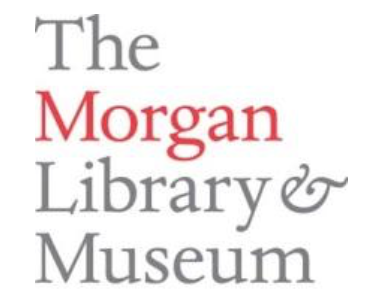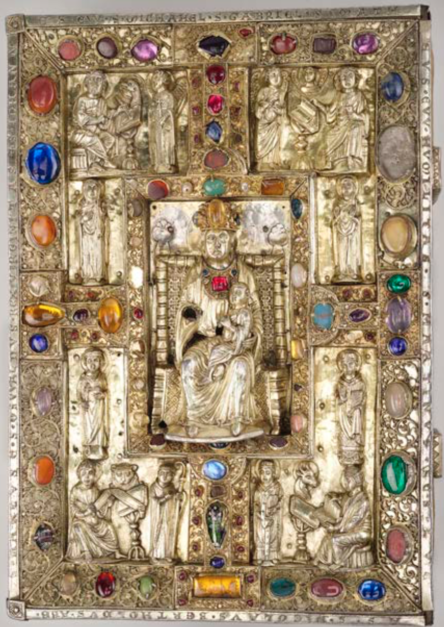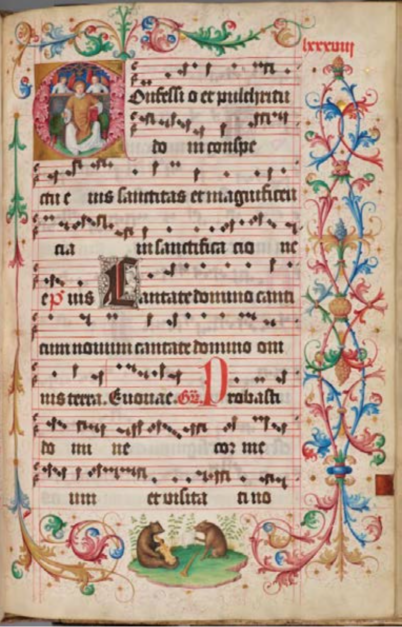
The Morgan Presents the Art of the Book in the Holy Roman Empire
Imperial Splendor: The Art of the
Book in the Holy Roman Empire, ca. 800–1500
October 15, 2021 through January 23, 2022
New York, NY (September 28, 2021) – The Morgan Library & Museum proudly presents Imperial Splendor: The Art of the Book in the Holy Roman Empire, ca. 800–1500, opening October 15, 2021, and running through January 23, 2022. The exhibition offers a sweeping overview of manuscript production in the Holy Roman Empire, one of the most impressive chapters in the history of medieval art. Rarely seen by the general public, these illuminated manuscripts are among the most luxurious works of art from the Middle Ages. Designed to edify, to entertain, and above all to embody the sacred, these manuscripts and their spectacular illuminations retain the ability to dazzle and inspire modern audiences just as they did those of the Middle Ages.
———————-

“Heiningen Gospels” (fragment), in Latin, Germany, Hamersleben, ca. 1180–1200. Morgan Library & Museum, MS M.565, fols. 13v–14r, Purchased by J. Pierpont Morgan, 1905
———————-
Encompassing at various times parts of modern-day Germany, Switzerland, Austria, the Czech Republic, Poland, the Low Countries, and northern Italy, the Holy Roman Empire played a crucial role in the patronage and development of the arts of the book. Throughout the Middle Ages, scribes and artists across the empire developed an array of visual techniques that transformed their manuscripts into vivid manifestations of power, prestige, and tradition. From dyed parchment and gold ink to full-page frontispieces and sweeping cycles of narrative illustrations, the striking features of these manuscripts lend them great presence and rhetorical grandeur. As this exhibition demonstrates, these books were not only repositories of knowledge, but also artistic protagonists used in rituals and ceremonies, agents of reform, and tools of propaganda.
The first major presentation of this subject in the English-speaking world, Imperial Splendor brings together some seventy manuscripts from collections across the country. Arranged chronologically, the exhibition’s three sections focus on different thematic points. “Imperial Networks” examines the precedents set by Carolingian and Ottonian Emperors, devoting attention to the development of a visual rhetoric of power. “Imperial Monasteries” demonstrates the important role of monasteries in the production of manuscripts as well as the closely related issue of aristocratic patronage. The final section, “Imperial Cities,” takes visitors on a tour of important urban centers in the fourteenth and fifteenth centuries, from Vienna and Prague to Cologne and Nuremberg. This final stop includes a consideration of the impact of Albrecht Dürer (1471–1528) and humanism on the arts of the book.
———————-

“Berthold Sacramentary,” in Latin Illuminated by the Berthold Master Germany, Weingarten, ca. 1215–17. Morgan Library & Museum, MS M.710, front cover. Purchased by J.P. Morgan, Jr., 1926.
———————-
Many of the manuscripts in Imperial Splendor were acquired under the leadership of Belle da Costa Greene (1879–1950), the Morgan’s founding Director and first keeper of manuscripts. Through her keen eye and widespread connections to leading scholars of the day, Greene was instrumental in shaping the collection and fostering access to it. Highlights of the exhibition include, in the first section, the tenth-century “Golden Gospels” (Germany, Trier, ca. 980), produced under Ottonian patronage. This spectacular manuscript was written entirely in gold ink on purple-painted parchment. The intended recipient is unknown, but in the sixteenth century it was owned by King Henry VIII of England. A highlight of the second section is the astounding “Berthold Sacramentary” (Germany, Weingarten, ca. 1215–17), which came about after a fire in 1215 consumed the monastery at Weingarten. Major relics were lost, and the abbey church had to be rebuilt. In this context of renewal, Abbot Berthold engaged a professional painter—known as the Berthold Master—to illuminate this Mass book, one of the great masterpieces of thirteenth-century painting. The manuscript preserves its original silk textiles and treasure binding. The final section features the monumental “Geese Book” (Germany, Nuremberg, ca. 1507–10), the largest manuscript in the Morgan’s collection, which was made for the church of Saint Lawrence in Nuremberg, and donated to the Morgan by Samuel Kress in 1961. Because of its exceptionally large size (65.4 x 44.5 cm), the manuscript has not been displayed publicly in over twenty years.
“The Morgan is thrilled to bring to light the group of rarely seen manuscripts presented in Imperial Splendor,” said the Morgan’s Director, Colin B. Bailey. “With many of these manuscripts having been among J Pierpont Morgan’s most important early acquisitions, a taste extended under the guidance of founding Director Belle da Costa Greene, the topic has deep roots at the Morgan, indeed.”
Joshua O’Driscoll, Ph.D., the Morgan’s Assistant Curator of Medieval and Renaissance Manuscripts and co-curator of the exhibition, said, “Imperial Splendor builds on one of the great strengths of the Morgan’s renowned holdings of illuminated manuscripts: its collection of Central European manuscripts, long acknowledged as one of the finest outside the German-speaking world. The exhibition also features important manuscripts from collections across the country, including institutions in Los Angeles, Chicago, Cleveland, Baltimore, and Philadelphia. In many instances, it marks the first time that related manuscripts from these collections have been brought together.”
Jeffrey F. Hamburger, Kuno Francke Professor of German Art and Culture at Harvard University and co-curator of the exhibition, said, “Collections across the United States hold a great wealth of illuminated manuscripts from Central Europe, material that by its nature is often hidden from view. For the first time, this exhibition brings together many of the most important to present an overview of the illustrated book across the entire span of the European Middle Ages, from the eighth century right up to the Reformation. These books were intended to dazzle, awe, and instruct anyone privileged enough to view them—and to this day they still do.”
———————-

“Geese Book,” in Latin Illuminated by Jakob Elsner (ca. 1460–1517). Germany, Nuremberg, ca. 1507–10. Morgan Library & Museum, MS M.905, vol. 1, fol. 194r. Gift of the Samuel H. Kress Foundation, December 1962.
———————-
The exhibition will be accompanied by an array of engaging public programs. Further details can be found here.
———————
Imperial Splendor: The Art of the Book in the Holy Roman Empire, ca. 800–1500
October 15, 2021 through January 23, 2022
———
The Morgan Library & Museum
225 Madison Avenue at 36th Street
New York, NY 10016
———————–
Organization and Sponsorship
Imperial Splendor: The Art of the Book in the Holy Roman Empire, ca. 800–1500 is made possible by the Janine Luke and Melvin R. Seiden Fund for Exhibitions and Publications, the Ricciardi Family Exhibition Fund, the Christian Humann Foundation, and Katharine J. Rayner. Additional support is provided by the David L. Klein Jr. Foundation; the Andrew W. Mellon Fund for Research and Publications; Caroline Sharfman Bacon; Elizabeth A. R. and Ralph S. Brown, Jr.; Mr. and Mrs. Alain Goldrach; Marguerite Steed Hoffman and Tom Lentz; Professor James H. Marrow and Dr. Emily Rose; Mrs. Andrew C. Schirrmeister; the Samuel H. Kress Foundation; Gifford Combs; Salle Vaughn; William M. Voelkle; Gregory T. Clark; Bob McCarthy; and an anonymous donor.
———————–
Morgan Library & Museum
A museum and independent research library located in the heart of New York City, the Morgan Library & Museum began as the personal library of financier, collector, and cultural benefactor Pierpont Morgan. The Morgan offers visitors close encounters with great works of human accomplishment in a setting treasured for its intimate scale and historic significance. Its collection of manuscripts, rare books, music, drawings, and works of art comprises a unique and dynamic record of civilization, as well as an incomparable repository of ideas and of the creative process from 4000 BC to the present.
————————–
The Morgan Library & Museum | 225 Madison Avenue | 212.685.0008 | themorgan.org
———————–

AAQ / Resource
Araiys Design Landscape Architects
_________________________________
